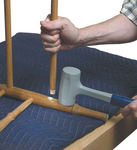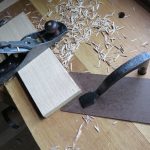We may receive a commission when you use our affiliate links. However, this does not impact our recommendations.
I was in Florida for a few days last week visiting my brother, niece, mom and stepfather. I stayed with my brother, Ian, who, like me (and other family members), inherited some woodworking tools from my grandfather. And as always when visiting with relatives, I pawed through the tools to see what interesting specimens I could find.
While my grandfather, Emmett Fitzpatrick, graduated from a trade school with a certificate in cabinetmaking, to the best of my knowledge he never worked professionally in the trade. I believe he did some industrial-scale woodworking while with the L&N railroad in the late 1930s, but following his discharge from the Army Air Corps in December 1945, he pursued a professional career in jewelry sales.
Woodworking, however, remained a hobby throughout his life, and he made and amassed a number of tools. One of them, a “gunstock scraper” or “ram’s horn scraper” is what I’m showing here.
 It’s basically a two-handled shop-made cabinet scraper, which functions rather like the Stanley #80 Cabinet Scraper, but made of wood instead of metal. And unlike many similar shop-made (and wooden commercial) versions, this one does not have a typical brass sole; instead, it appears to be an offcut of linoleum or possibly Bakelite; I’m leaning toward linoleum, because I think I’ve seen pictures of a room in my grandparents’ house that had what looks to be a floor of that approximate color.
It’s basically a two-handled shop-made cabinet scraper, which functions rather like the Stanley #80 Cabinet Scraper, but made of wood instead of metal. And unlike many similar shop-made (and wooden commercial) versions, this one does not have a typical brass sole; instead, it appears to be an offcut of linoleum or possibly Bakelite; I’m leaning toward linoleum, because I think I’ve seen pictures of a room in my grandparents’ house that had what looks to be a floor of that approximate color.
I thought about disassembling the tool to get a better look at the pieces and how they go together..but due to a couple stripped screws and rusted metal, I had concerns about getting it apart and back together safely without some time and attention (neither of which I had time to give on this trip).
So instead, I looked online and found patent No. 723,143, issued in 1903 to Louis F. Deffaulx for an “improved wood scraper” that looks to be the one to be manufactured by EC Atkins; it’s the closest I could find to a plan for my grandfather’s tool, though there are obvious differences. (You can get a look at that patent here: WoodScraperPatent)
If I didn’t already have a Stanley No. 80, I’d probably take a shot at making a replica…or perhaps asking for a long-term loan from my brother to see if I could clean up and use grandpa’s scraper (though goodness knows I already have enough projects to be getting on with). But I sure wish I had more time to look at that sole – it’s far and away the most curious thing about this tool.
p.s. If you have a cache of old woodworking tools (mostly of the metal variety) that you’d like to get back into shop shape, take a look at Mike Dunbar’s newly updated “Restoring, Tuning & using Classic Woodworking Tools.”
Here are some supplies and tools we find essential in our everyday work around the shop. We may receive a commission from sales referred by our links; however, we have carefully selected these products for their usefulness and quality.














Couldn’t access comments at work, and forgot about it, so not sure if you will even see this. If you have a friend who does old car restoration ask if it might not be the backer pad material for car brakes. Specifically Chrysler Plymouth 20’s to 30’s. Same Salmon color, heat and friction it would hold up a lot longer than linoleum. Old tools were frequently supplemented by automotive parts, and pieces.
Kool tool with provenance. Can’t beat that with a shillelagh.
I have seen similarly colored linoleum like material used as wear surfaces of pattern makers tools. Suggested to me the material was used in paternmaking and so handy for custom tools as well.